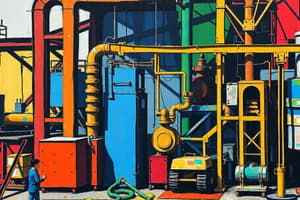Podcast
Questions and Answers
What is the primary purpose of a function in the context of analyzing relationships between variables?
What is the primary purpose of a function in the context of analyzing relationships between variables?
- To complicate the relationship between variables.
- To symbolize and explain the relationship between variables. (correct)
- To determine the value of only the independent variables.
- To obscure the link between dependent and independent variables.
In the functional relationship D = f(P), what does 'D' represent?
In the functional relationship D = f(P), what does 'D' represent?
- The function of the price.
- The quantity supplied.
- The price of the commodity.
- The demand of the commodity. (correct)
Which of the following best describes a function where the variables are interdependent?
Which of the following best describes a function where the variables are interdependent?
- An implicit function. (correct)
- A quadratic function.
- A linear function.
- An explicit function.
What does an equation represent in economics, when compared to a verbal expression?
What does an equation represent in economics, when compared to a verbal expression?
In the context of equations, what are the two expressions of an equation typically known as?
In the context of equations, what are the two expressions of an equation typically known as?
In the consumption function C = a + bc, what does 'a' represent?
In the consumption function C = a + bc, what does 'a' represent?
According to the content, which of the following indicates where the firm has neither a profit nor a loss?
According to the content, which of the following indicates where the firm has neither a profit nor a loss?
According to the content provided, a firm's equilibrium output is produced where:
According to the content provided, a firm's equilibrium output is produced where:
What is the primary weakness of a minimum wage in addressing poverty?
What is the primary weakness of a minimum wage in addressing poverty?
How does the concept of economic rent differ from regular rent?
How does the concept of economic rent differ from regular rent?
What factor makes the supply of land inelastic?
What factor makes the supply of land inelastic?
What determines the demand for land according to marginal revenue product (MRP)?
What determines the demand for land according to marginal revenue product (MRP)?
In which scenario is the demand curve for land likely to slope downward?
In which scenario is the demand curve for land likely to slope downward?
What happens to the monopolist's profit at higher prices when there are no alternative firms producing the same commodity?
What happens to the monopolist's profit at higher prices when there are no alternative firms producing the same commodity?
How is a monopolist's equilibrium defined in relation to marginal revenue and marginal cost?
How is a monopolist's equilibrium defined in relation to marginal revenue and marginal cost?
What characterizes the supernormal profit observed for a monopolist?
What characterizes the supernormal profit observed for a monopolist?
What is one of the advantages of a monopoly regarding innovation?
What is one of the advantages of a monopoly regarding innovation?
In what situation might a monopoly face competition?
In what situation might a monopoly face competition?
What does the long-run equilibrium of a monopolist depend on compared to short-run equilibrium?
What does the long-run equilibrium of a monopolist depend on compared to short-run equilibrium?
What effect does a less elastic demand curve have on a monopolist's profit?
What effect does a less elastic demand curve have on a monopolist's profit?
Which of the following best describes the consequence of an inefficiently run monopoly?
Which of the following best describes the consequence of an inefficiently run monopoly?
In monopolistic competition, how is profit maximized?
In monopolistic competition, how is profit maximized?
What characterizes the demand curve for a monopolistically competitive firm compared to a monopolist?
What characterizes the demand curve for a monopolistically competitive firm compared to a monopolist?
What factor most significantly affects the short-run profit of a monopolistically competitive firm?
What factor most significantly affects the short-run profit of a monopolistically competitive firm?
What happens when firms are earning supernormal profits in monopolistic competition?
What happens when firms are earning supernormal profits in monopolistic competition?
What causes the demand curve for established firms to shift to the left in the long run?
What causes the demand curve for established firms to shift to the left in the long run?
Which statement about short-run equilibrium is accurate for monopolistic competition?
Which statement about short-run equilibrium is accurate for monopolistic competition?
Which condition must be met for a monopolistically competitive firm to continue production in the short run?
Which condition must be met for a monopolistically competitive firm to continue production in the short run?
What will typically happen to the market in the long run if established firms are earning supernormal profits?
What will typically happen to the market in the long run if established firms are earning supernormal profits?
What defines the long-run equilibrium of a firm in monopolistic competition?
What defines the long-run equilibrium of a firm in monopolistic competition?
Which of the following is a key characteristic of an oligopoly?
Which of the following is a key characteristic of an oligopoly?
What is a likely outcome in a collusive oligopoly?
What is a likely outcome in a collusive oligopoly?
Which factor can limit the application of monopolistic competition models in real-world situations?
Which factor can limit the application of monopolistic competition models in real-world situations?
In non-collusive oligopoly, firms typically engage in which behavior?
In non-collusive oligopoly, firms typically engage in which behavior?
What is a significant challenge when analyzing the demand curve in markets with differentiated products?
What is a significant challenge when analyzing the demand curve in markets with differentiated products?
Which of the following companies is considered part of an oligopoly market structure?
Which of the following companies is considered part of an oligopoly market structure?
What is one of the effects of price and output decisions in monopolistic competition?
What is one of the effects of price and output decisions in monopolistic competition?
What is a characteristic feature of monopolistic competition compared to perfect competition?
What is a characteristic feature of monopolistic competition compared to perfect competition?
In the context of monopolistic competition, short-run equilibrium occurs when which of the following conditions is met?
In the context of monopolistic competition, short-run equilibrium occurs when which of the following conditions is met?
Which of the following statements about monopolists is correct?
Which of the following statements about monopolists is correct?
Which situation best illustrates the concept of non-collusive oligopoly behavior?
Which situation best illustrates the concept of non-collusive oligopoly behavior?
What is the primary limitation of the model of monopolistic competition?
What is the primary limitation of the model of monopolistic competition?
Which of the following is a key assumption in the study of monopolistic competition?
Which of the following is a key assumption in the study of monopolistic competition?
In long-run equilibrium for monopolistic competition, firms will operate where which of the following conditions hold?
In long-run equilibrium for monopolistic competition, firms will operate where which of the following conditions hold?
What distinguishes monopolistic competition from pure monopoly?
What distinguishes monopolistic competition from pure monopoly?
Flashcards
Function in Economics
Function in Economics
A mathematical representation of the relationship between variables.
Explicit Function
Explicit Function
A function where the dependent variable is expressed directly in terms of the independent variable.
Implicit Function
Implicit Function
A function where the relationship between variables is implied, but not explicitly stated.
Equation
Equation
Signup and view all the flashcards
Break-Even Point
Break-Even Point
Signup and view all the flashcards
Marginal Revenue (MR)
Marginal Revenue (MR)
Signup and view all the flashcards
Marginal Cost (MC)
Marginal Cost (MC)
Signup and view all the flashcards
Short-Run Equilibrium of the Firm
Short-Run Equilibrium of the Firm
Signup and view all the flashcards
Monopoly
Monopoly
Signup and view all the flashcards
Monopoly Equilibrium
Monopoly Equilibrium
Signup and view all the flashcards
Supernormal Profit
Supernormal Profit
Signup and view all the flashcards
Demand Curve
Demand Curve
Signup and view all the flashcards
Pricing Power
Pricing Power
Signup and view all the flashcards
Long-Run Equilibrium
Long-Run Equilibrium
Signup and view all the flashcards
Corporate Control Competition
Corporate Control Competition
Signup and view all the flashcards
Innovation and New Products
Innovation and New Products
Signup and view all the flashcards
Monopolistic Competition
Monopolistic Competition
Signup and view all the flashcards
Short-run Equilibrium in Monopolistic Competition
Short-run Equilibrium in Monopolistic Competition
Signup and view all the flashcards
Profit (or Loss)
Profit (or Loss)
Signup and view all the flashcards
Long-run Equilibrium in Monopolistic Competition
Long-run Equilibrium in Monopolistic Competition
Signup and view all the flashcards
Product Differentiation
Product Differentiation
Signup and view all the flashcards
Marketing & Advertising
Marketing & Advertising
Signup and view all the flashcards
Market Power
Market Power
Signup and view all the flashcards
Short-Run Equilibrium
Short-Run Equilibrium
Signup and view all the flashcards
Limitations of Monopolistic Competition
Limitations of Monopolistic Competition
Signup and view all the flashcards
Monopoly Price Discrimination
Monopoly Price Discrimination
Signup and view all the flashcards
Non-Collusive Oligopoly
Non-Collusive Oligopoly
Signup and view all the flashcards
Oligopoly
Oligopoly
Signup and view all the flashcards
Non-price competition
Non-price competition
Signup and view all the flashcards
Collusive Oligopoly
Collusive Oligopoly
Signup and view all the flashcards
Long-run Equilibrium of the Firm
Long-run Equilibrium of the Firm
Signup and view all the flashcards
Economic Rent
Economic Rent
Signup and view all the flashcards
Minimum Wage & Poverty
Minimum Wage & Poverty
Signup and view all the flashcards
Inelastic Supply of Land
Inelastic Supply of Land
Signup and view all the flashcards
Demand for Land
Demand for Land
Signup and view all the flashcards
Supply of Land
Supply of Land
Signup and view all the flashcards
Study Notes
Course Objectives
- Explain microeconomics as a branch of economics
- Examine the foundations of microeconomics
- Analyze basic microeconomic theory
- Critically examine the concept of market structure
- Critically examine privatization and commercialization in Nigeria
Course Contents
- Module 1: Introduction to the Context of Economics
- Unit 1: Introduction to Economics
- Unit 2: Basic Tools in Economic Analysis
- Unit 3: Microeconomics
- Unit 4: Microeconomics and Choice
- Unit 5: Economic Systems and Organization
- Module 2: Foundations of Economics
- Unit 6: Theory of Demand
- Unit 7: Theory of Supply
- Unit 8: Elasticity
- Module 3: Introduction to Microeconomic Theory
- Unit 9: Theory of Consumer Behaviour
- Unit 10: Theory of Cost
- Module 4: Market Structure
- Unit 11: Perfect Competition
- Unit 12: Monopoly
- Unit 13: Monopolistic Competition
- Unit 14: Oligopoly
- Unit 15: Pricing and Employment of Resources
- Unit 16: The Theory of Contestable Markets
- Unit 17: Privatization and Commercialization in Nigeria
- Unit 18: Return to Scale
Studying That Suits You
Use AI to generate personalized quizzes and flashcards to suit your learning preferences.
Related Documents
Description
Test your understanding of functions and their roles in economics with this quiz. The questions cover the functional relationships between variables, the consumption function, and equilibrium output. Enhance your knowledge of these key economic concepts.




